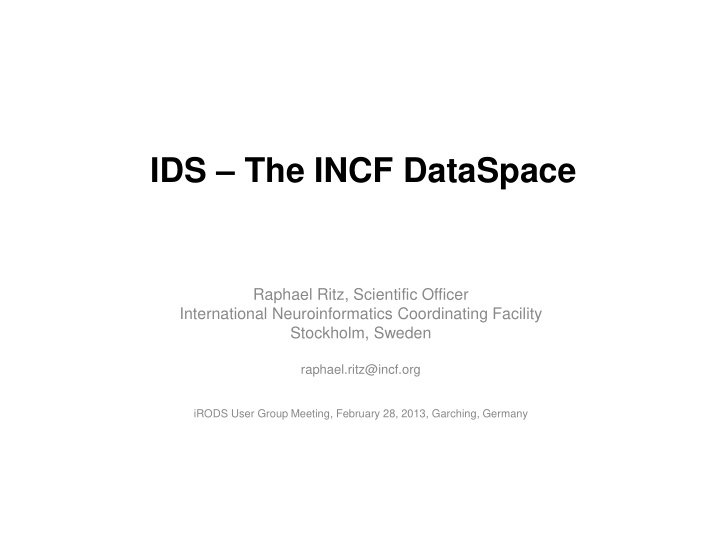



IDS – The INCF DataSpace Raphael Ritz, Scientific Officer International Neuroinformatics Coordinating Facility Stockholm, Sweden raphael.ritz@incf.org iRODS User Group Meeting, February 28, 2013, Garching, Germany
Multiomic Neuroscience Data Confocal Single Cell Protein Electron Microarrays Magnetic bead Microscopy Microscopy PCR quantification Gene Gene Gene over- Two-hybrid Protein Genetic sequencing silencing expression vectors system separation Wholecell & Laser micro- Fluorescence Cellular Cell Cell culture Inside-Out Patch sorting dissection microscopy tracing In situ Rhodopsin Mass- Organelle Spatial Immuno-detection amplified by T7 spectroscopy transfection Proteomics hybridization vectors Enzymatic-activity Immuno- Multi Electrode Array 2DE proteomics Tissue Dye Imaging staining measurement Extracellular Recording transfection Magnet Transgenic lines EEG Ultramicroscopy fMRI 2 Behavioral Studies Resonance Diffusion Imaging
to replicate experiments to ask new questions to visualize to simulate to analyze How do we bring all this data together? to model to search to share to publish to teach 3
The Birth of INCF • The Global Science Forum of OECD realized the need for a concerted action for developing Neuroinformatics on the international level • 2005 INCF plans endorsed by the ministers of research of OECD • August 1st 2005 INCF formed with 7 members including Japan and the US 4
The mission of INCF • Coordinate and foster international activities in neuroinformatics • Contribute to development and maintenance of database and computational infrastructure and support mechanisms for neuroscience applications • Enable access to all freely accessible data and analysis resources for human brain research to the international research community • Develop mechanisms for the seamless flow of information and knowledge between academia, private enterprises and the publication industry 5
In general data sharing is difficult “ Where do I put my data to share it? ” “ How can I share my data with you (and only you)? ” “ Where can I backup my data? ” “ Where can I look for shared data? ” 6
How can we make it easier? • Let ’ s make data sharing as simple as possible - like a Dropbox for Scientists • Drag and drop any type of data, text, images • Don ’ t worry about metadata (yet) 7
ids.incf.net 8
INCF Data Space (IDS) - Architecture
Deployment • Central servers in the Amazon Cloud (EC2) • Replicated across 4 availability zones • Master in Europe • Slaves in US-East, US-West, AP-NE • Community contributed data and zone servers • Debian packages (RPMs coming) • EC2: Region-specific cloud formation templates • IDS Tools: utilities to setup and maintain servers 11
Information Architecture • Users have home folders in the INCF zone backed by INCF-managed resource servers (quotas enforced) • Contributed data servers are hooked up at • /incf/resources/<reverse domain name> • Rules define and enforce which resource receives uploads based on location in namespace 12
Web Interface: ids.incf.net
Command Line Client: icommands
Desktop Integration: irodsFuse
• INCF central authentication • User defined access control (Private, Public, Group) • Policy based group data access (e.g. data use agreement) • Standardized navigation structure and policies • Globally distributed zones - distributed data storage costs 16
• Built existing technology – iRODS • Scales with the Amazon Cloud • Supports data replication across the federation • Planning on federated search using NIF portal (neuinfo.org) • Provides strong data management foundation for future developments (arbitrary metadata, provenance, replication, archival, etc) 17
• Things we needed to add: • PAM support to authenticate against the INCF LDAP • Storage admin user to avoid the propagation of rodsadmins • Thanks to Chris Smith, Wayne Schroeder and Mike Convay for the implementation. 18
Theming the web ui: diazo.org 19
Growing the Federation • Challenges • People already have “some systems” – need to fit existing environments • EC2 is hard to pay for - and not necessarily cheaper than a university environment • Integrate at application rather than file level • EUDAT • Simple Storage • Safe Replication • Persistent Identifiers 20
Further Information • Web access to the data space: https://ids.incf.net • High level information: http://dataspace.incf.org • Tools and clients: http://github.com/INCF/ids- tools/wiki • Developers corner: • http://dev.incf.org/trac/infrastructure • http://github.com/INCF/ids-tools • Contact: ids-admin@incf.org 21
Documentation • For end users: video tutorials • http://www.youtube.com/user/INCForg • Design documents • http://dev.incf.org/trac/infrastructure/wiki • For administrators: data&zone servers • http://github.com/INCF/ids-tools/wiki • Background reading: a workshop report • http://www.incf.org/programs/workshops/scientific- workshops/ci-1 22
Contributors • Sean Hill • Chris Smith • Sina Khaknezhad • EUDAT • Ylva Lillberg • Johannes Reetz • Beatriz Martin • Dejan Vitlacil • Mathew Abrams 23
@ Contact info: gsoc@incf.org Web: www.incf.org/gsoc 1
Recommend
More recommend